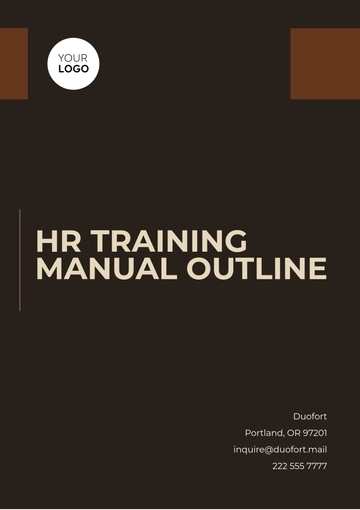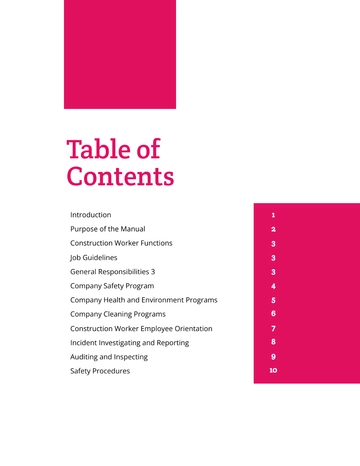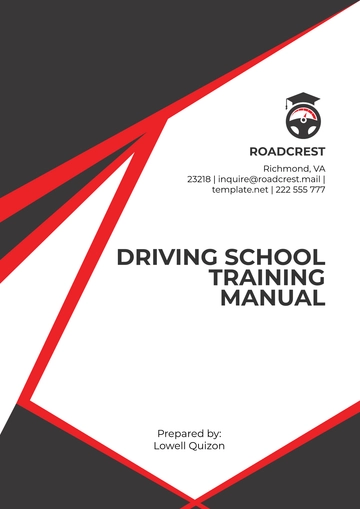Free Sales Training Manual for Engaging Trade Show Attendees

I. Introduction
Welcome to [Your Company Name]'s Training Manual on effectively engaging trade show attendees. Trade shows represent a unique platform where we can foster meaningful connections, showcase our innovations, and further our brand's reach. At our company, we emphasize the importance of every interaction at such events, as each presents a potential business and networking opportunity.
This manual is designed to provide you with actionable strategies, insights, and best practices to ensure that our representation at trade shows not only meets but exceeds the standards of excellence we uphold as a company. Your commitment to mastering the contents of this manual will play a pivotal role in solidifying [Your Company Name]'s position as an industry leader.
II. Understanding Trade Show Attendees
Trade shows are a melting pot for diverse attendees, each with varying familiarity with our products, services, and brand ethos. It's important to understand the nuances of this diverse audience to tailor our engagement tactics accordingly.
A. Profile of Typical Trade Show Attendees
Year | First Time Attendees | Repeat Attendees | Average Time Spent |
2050 | 45% | 55% | 3.2 Hours |
B. Key Insights
The consistent presence of both first-time and repeat attendees, as shown in the table above, underscores the need for a multi-faceted approach to engagement. Tailored interactions will ensure first-timers feel welcomed while repeat attendees feel valued.
The average time attendees spend is over three hours, offering ample opportunities for meaningful interactions. Efficient booth design, product placement, and staff accessibility can optimize this engagement window.
First-time attendees often seek a broad overview, while repeat attendees might be interested in updates or deeper product knowledge. Training our staff to quickly gauge attendee familiarity can significantly enhance interaction quality.
In essence, understanding the varied attendee profiles and anticipating their expectations will set the foundation for successful trade show engagements. Being attuned to their needs ensures that we leave a lasting, positive impression, bolstering our company’s reputation and potential business opportunities.
III. Key Engagement Strategies
To succeed in a trade show, we must be proactive, insightful, and adept at capturing the attention of attendees. Key engagement strategies not only enhance our brand's visibility but also cement our position as an industry frontrunner. Here are our foundational strategies, elaborated to provide clear guidance for effective attendee engagement:
A. Interactive Demos
Beyond just showcasing our products, allow attendees to immerse themselves in a hands-on experience. An interactive demonstration can bridge the gap between mere interest and genuine investment, making our offerings memorable.
B. Engaging Content
Curate a narrative around our products and services. Highlight success stories, feature compelling testimonials, and showcase real-world use cases. This narrative approach humanizes our brand and establishes a deeper connection with attendees.
C. Knowledgeable Staff
Our representatives are the face of [Your Company Name] at these events. Our staff must be well-versed in every aspect of our product range. Their ability to confidently address queries, provide in-depth insights, and maintain an enthusiastic demeanor can significantly elevate the attendee's experience.
D. Active Listening
Ensure that we are not just communicating our message but also actively listening to the attendees. Understand their needs, feedback, and pain points. This two-way communication instills trust and positions [Your Company Name] as a brand that values its stakeholders.
E. Value-driven Giveaways
Thoughtful giveaways that align with our brand and offer utility can be lasting reminders of their interaction with us. Instead of generic items, consider giveaways that resonate with our product themes or emphasize our brand values.
By meticulously implementing these strategies, we can ensure that our engagement is transactional and transformational, fostering lasting relationships with potential clients and partners.
IV. The Role of Visual Presentation
In an environment of trade shows, attendees are frequently bombarded with a myriad of stimuli. Visual presentation, therefore, plays a pivotal role in distinguishing [Your Company Name] from the competition and creating an immediate and lasting impact.
A. Attendee's Perception Based on Visual Presentation
Year | Positive Perception | Neutral Perception | Negative Perception |
2050 | 68% | 20% | 12% |
B. Key Considerations
Branding Consistency: Every visual element, from the grandeur of banners to the intricate details of brochures, must be in harmony with the company’s branding guidelines. This unwavering consistency not only underscores our brand's identity but also bolsters recall, leaving a lasting impression on attendees.
Strategic Layout Design: Initiate the attendee's journey with captivating headlines that pique interest. Subsequently, highlight the salient benefits of our offerings and always culminate with an unmistakable call to action. To ensure clarity and focus, judiciously employ whitespace, allowing the content to breathe and reducing cognitive load for the viewer.
Quality and Authenticity in Imagery: Embrace high-resolution images that resonate with our target demographic. Prioritize authentic visuals that capture real users interacting with our products or offer candid behind-the-scenes snapshots. Such genuine imagery not only humanizes our company but also engenders trust and relatability.
Engaging Interactive Elements: Introduce dynamic touchpoints that beckon attendees to engage. Whether it's the allure of interactive screens detailing product features, the convenience of QR codes linking to exclusive content, or the immersive wonders of augmented reality showcases, these innovations promise deeper engagement and longer booth dwell times.
Feedback-Driven Refinement: After the trade show's curtains fall, actively seek feedback concerning our visual presentation from both attendees and our dedicated staff. Treat every event as a learning experience, with feedback serving as invaluable input for our continuous drive toward perfection and heightened effectiveness.
A compelling visual presentation is not merely about aesthetics; it's a strategic tool that can amplify our brand’s message, foster deeper connections, and drive actionable results. Investing time and resources in honing this aspect will undoubtedly yield dividends in the form of enhanced attendee engagement and brand recognition.
V. Leveraging Technology
In an era of rapid technological advancements, it's paramount for [Your Company Name] to integrate cutting-edge solutions to create a superior trade show experience. The infusion of technology can not only captivate attendees but also streamline our engagement processes.
A. Virtual Reality and Augmented Reality
Introduce immersive VR demos that transport attendees into the world of our products or services. Alternatively, use AR to overlay digital information on physical products, giving attendees a richer understanding.
B. Interactive Touchscreens
Employ touchscreens to showcase product catalogs, video testimonials, or interactive product configurators. This self-guided exploration allows attendees to engage with our offerings at their own pace.
C. Mobile Applications
Develop or integrate with trade show-specific mobile applications. These apps can offer booth locators, appointment scheduling, or even gamified experiences to enhance attendee engagement.
D. Digital Data Collection
Replace traditional paper-based lead collection with digital solutions. Tablets or digital interfaces can capture attendee details, preferences, and feedback, ensuring accurate and organized data storage.
E. Live Social Media Integration
Amplify our presence by showcasing real-time social media feeds at our booth. Encourage attendees to share their experiences, photos, or insights using a dedicated event hashtag.
VI. Metrics and Analytics
In today's data-centric business landscape, relying solely on qualitative feedback is insufficient. For [Your Company Name] to truly gauge the efficacy of our trade show strategies and to continually innovate, it's crucial to delve deep into metrics and analytics.
A. Key Performance Indicators (KPIs) to Monitor
Booth Traffic: A basic yet essential metric. Monitoring the number of visitors can provide insights into booth placement, attractiveness, and staff performance.
Lead Conversion Rate: Out of the total visitors, how many were converted into actionable leads? This metric can offer a clear picture of the quality of interactions and engagements.
Engagement Duration: With the help of technology, track the average time attendees spend at our booth. Longer engagement times often correlate with heightened interest.
Digital Interactions: Monitor the usage of digital tools like touchscreens, mobile app engagements, or VR/AR experiences. High usage indicates effective technological integration.
Social Media Mentions: Track mentions, shares, and interactions related to our trade show presence. This metric provides insights into our digital reach and brand sentiment.
B. Data Interpretation and Action
Benchmarking: Regularly compare our KPIs against industry standards or previous trade show performances. This comparative analysis can highlight areas of strength and potential improvement.
Feedback Integration: Marry the quantitative data with qualitative feedback from staff and attendees. Such a holistic approach ensures a more comprehensive understanding of our performance.
Strategy Refinement: Use the analytical insights to refine our trade show strategy. Whether it's repositioning our booth, incorporating new technologies, or altering engagement techniques, let data be the guiding force.
Metrics and analytics are not mere numbers; they are the pulse of our trade show performance. Embracing a data-driven mindset ensures that [Your Company Name] remains agile, proactive, and continually poised for success in the ever-evolving trade show landscape.
VII. Follow-Up Best Practices
The conclusion of a trade show is merely the beginning of a longer journey with potential leads and partners. Our follow-up approach can significantly influence the conversion of these leads and the overall perception of [Your Company Name].
A. Promptness
Time is of the essence. Initiate follow-up communications within 48 hours of the event's conclusion. This immediacy reflects our commitment and keeps our company fresh in the attendee's mind.
B. Segmentation
Categorize leads based on their interactions, interests, or potential value. Tailored communications for each segment ensure relevancy and enhance engagement chances.
C. Personalization
Generic follow-ups often fall flat. Personalize communications by referencing specific interactions, discussions, or products the attendee showed interest in.
D. Value Addition
Rather than mere sales pitches, provide value in your follow-ups. This could be in the form of industry insights, exclusive offers, or educational content related to the attendee's interests.
E. Feedback Solicitation
Use the follow-up as an opportunity to solicit feedback about our booth, products, or engagement strategies. Such feedback can be instrumental in refining our approach for future events.
F. Consistent Communication
Instead of a one-off communication, establish a cadence of touchpoints. Regular updates, newsletters, or product announcements can keep our company in the attendee's mind.
Incorporating these best practices ensures that our post-trade show efforts are as strategic and effective as our on-ground engagements. These continued interactions solidify relationships, fostering brand loyalty and increasing the likelihood of fruitful collaborations.
VIII. Conclusion
Engaging trade show attendees is a mix of art and science. With the right strategies, visuals, and follow-up practices, [Your Company Name] can maximize the benefits of trade show participation. Always remember the quality of engagement is as crucial as the quantity.
- 100% Customizable, free editor
- Access 1 Million+ Templates, photo’s & graphics
- Download or share as a template
- Click and replace photos, graphics, text, backgrounds
- Resize, crop, AI write & more
- Access advanced editor
Equip your team with the skills to engage trade show attendees with our Sales Training Manual for Engaging Trade Show Attendees Template! This fully editable and customizable manual from Template.net ensures you provide a comprehensive training program that elevates your team’s engagement skills. Generate easily with our AI Editor Tool!





























